Paul steadies the wheel from the starboard side of the boat while Captain Scott Hamilton hand ties leaders for our 12 weight rigs as we idle through the no wake zone of Palm Beach’s busy harbor. We’re flanked by countless other fishing boats, day cruisers, dive boats and yachts. As we emerge past the jetty’s point and step up to speed, we can see the earliest of beachgoers staking their spots for the day, the busy Florida town’s high rises looming behind them.
Within a few hours the beach will grow crowded, as will its nearshore waters. Women in bikinis will sun themselves on the sand, kids will splash and swim in the surf, and snorkelers and divers will explore the world beneath the waves. And all the while, we'll drift and slowly motor in Scott’s boat — never out of sight of the beach and often within several hundred yards of shore — taking our part in a 400 million year old nightmare that has been playing itself out, seemingly endlessly, since the Devonian age.

Beneath the beautiful, emerald blue-green waters of Florida’s southeastern coast is an unlimited engagement of a horror story whose role players spend virtually every waking moment attempting to avoid a grizzly death; as if forever doomed to reprise Marilyn Burns’ 1974 role as Sally Hardesty fleeing a chainsaw wielding maniac through the Texas brush and bramble.
This is a world where there’s almost always something bigger than you lurking around the corner trying to eat you. Only, in truth, there are no corners or even bends to hide around. Just an open blue ocean, filled with predators.
Snarly blue runners pick off baitfish, but are often chased off by bigger jack crevalle that swarm and push the runners off the bigger bait balls and better fish. When false albacore are around, they outcompete the jacks, blitzing in to snatch prey so quickly that they’re impossible to resolve with the eye, only their characteristic streaks — which look like discharges from an underwater Tesla coil — created by the sun flaring off their impossibly silver sides, are seen.
Peering over the edge of the boat at the scene below, the primal, eat-or-be-eaten world below differs so starkly from the commonly held image of the marine world, that it’s hard to believe that the folks at Disney that created the underwater worlds of Finding Nemo or Bedknobs and Broomsticks spent any time in the field whatsoever before creating their illustrations.

Conversely, it’s particularly easy to believe the results of research that has shown that fish potentially evolve to have low stress levels; at least fish that live in places like Palm Beach. Fish with Woody Allen’s propensity for handling difficult situations or perceived threats, thrown into the feeding frenzy perpetually underway in the southeast Atlantic’s pelagic zones, would quickly die from exhaustion and energy expenditure. Natural selection would weed them out quick.
And there’s the sharks. Bull sharks, mostly. Often as many as a dozen circling placidly below, confidently choosing their moments to strike. Most commonly, this is when we’ve hooked up a fish. Particularly if it is a nicely sized false albacore. It’s the albies — which Floridians often colloquially refer to as bonita but should not be confused with their close relative the bonito — which we’ve come in search of.

Scott has us on them almost immediately after we escape the harbor. Spying an “albie-looking” disturbance on the surface in the distance, we motor over, cut the engine and peer over the now placid water looking for signs of bonita. Scott tosses four or five small, live baitfish — pilchards, scaled sardines two inches or so in length — into a fat, novelty kids’ baseball bat he’s severed the end off of, and heaves them lacrosse-style into the water. Each pilchard makes the most miniscule of plops as they helplessly fall to the water’s surface. There’s a moment, maybe two, of silence and then the water erupts. Albies slash in crossing patterns to snatch up the tiny sardines, tearing up the surface like 300 pound crocodiles.
We've found what we came for, but the sharks keep spoiling things. At first, we bring in a few nice false albacore, but lose more to the sharks than we bring in. Albies pull hard in long, deep, ploying runs and burn up reels in a particularly gratifying way. But, the line lurches each time when the shark grabs, then goes slack, and we get back what part of the leader the shark has left us. No fish. No fly. One time we lose the better part of a fly line. Before long, the bulls have cued in on what we’re doing and the albies stop making it back to the boat entirely, leaving only blue runners and jacks to make it to hand.

We cut and run several times, but where we find albies, we find sharks. Before altering the game plan altogether, Scott takes us on a long run to a nearshore spot where a sea floor rockpile and shipwreck attract both divers and snorkelers and fish. Once again, we find bonita, only this time the sharks haven’t.
We drift over the rock piles, hooking up one albie after another, most in the 10-20 pound range. We test our reels, our ability to scramble around the boat over and under each other with multiple fish hooked up and even our ability not to break the sturdy Redington Vapen 12 weights we’re fishing against the outboard motors when the albies drag us around the back of the boat and dive deep at just the wrong moment — a fate which Scott saves us from more than once by grabbing the rods and somehow wrestling them free.

Paul, Jay, David and I each land several nice fish, and we take our time enjoying the shark-free water we’ve landed ourselves in. As arms tire, we trade off shots from the stern and the bow more frequently. After a while, the action begins to slow, but after a small drought my line goes tight and I find myself hooked to what feels like a particularly hardy bonita.
After a characteristic long, deepening run the line unexpectedly comes to the surface and we spot the albie — comfortably over 20 pounds — seemingly surfing in the swell off in the distance. It dives briefly, and then emerges from the surface again. Only this time, it’s tipped sideways and followed by the large, blue-grey dorsal of a bottlenose dolphin.
With the line, led by extremely difficult to break 25 pound mono, squarely hooked to the bonita that’s now clenched in the jaws of the bottlenose, we wait to see if the dolphin will decide to spool us — which it easily can. It hangs near the surface, pulling stiffly at the 12 weight and peeling line and Scott chases with the boat to lighten the load. But rather than take off, the dolphin seems content to circle the boat taking only relatively brief, directional runs while holding onto its catch.
After several minutes, I find myself wondering what the end game is. The line seems unlikely to break, and the dolphin uninterested in taking off altogether. It also seems unlikely to me that the dolphin, lacking the teeth and gaping maw of a shark, can simply break off what part it wants of the albie or swallow it whole, severing our line in the process and breaking us free. But as the bottlenose yanks at the Vapen and my shoulder, Scott explains the likely outcome — the dolphin, clenching the bonita in its jaws just where the head meets the spine, will snap the fish in half with a confident head shake. And, sure enough, after a few more minutes go by the load on the line gets considerably lighter and I'm able to reel in a hundred yards of backing and a hundred feet more of fly line which now tows in only the bonita's head.

With the return of an apex predator, the false albacore have lost their temporary rung at the top of the food chain and they're gone. Even the big jacks are gone. We circle the rocks a few more times but find only blue runners. Moments later, we spot the dorsals of a few more bottlenose and we know the jig is up. With arms sore and skin worn by the hot, tropical sun we decide to call it a day and the breeze we're rewarded with on the long run back to the harbor is a welcome respite from the relentless heat of the day.
As we motor away, we've relinquished our self-chosen role in the nightmare at play beneath the waves. The fish, of course, haven't noticed and in the distance we spy splashing and slashing disturbing the water's surface at regular intervals. Birds spy it too, and flock over to pick up the scraps of baitfish left behind by frenzied bonita and jacks. The bulls, too, are presumably wise to the goings on as well — arriving periodically to take their pick of the best and biggest prey. As we near the harbor and people watch sunbathers on their towels and kids at play in the sand, the unlimited engagement at work in the water just offshore keeps playing. Same as it ever has.




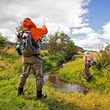
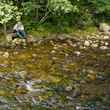








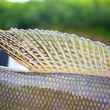




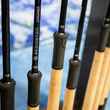
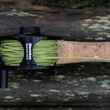



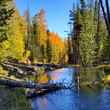
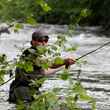


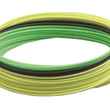

Comments
ginkthefly replied on Permalink
Blue water fly fishing is something I'm just beginning to explore after years of writing it off as something for the gear guys ..... and boy am I glad I am. It's an absolute charge and very different than anything else you'll find in fly fishing ... even other stuff in the salt.
DBC replied on Permalink
Did this with Scott for years when I still had a place in Boca, great fun but half a day will beat you to your knees, had a lit up Blue Marlin eat my Albie in front of several Sportfishermen, pretty cool for about thirty seconds!
Book him for Spinner Sharks, throwing international orange poppers with a twelve weight, ooh boy!
Pages